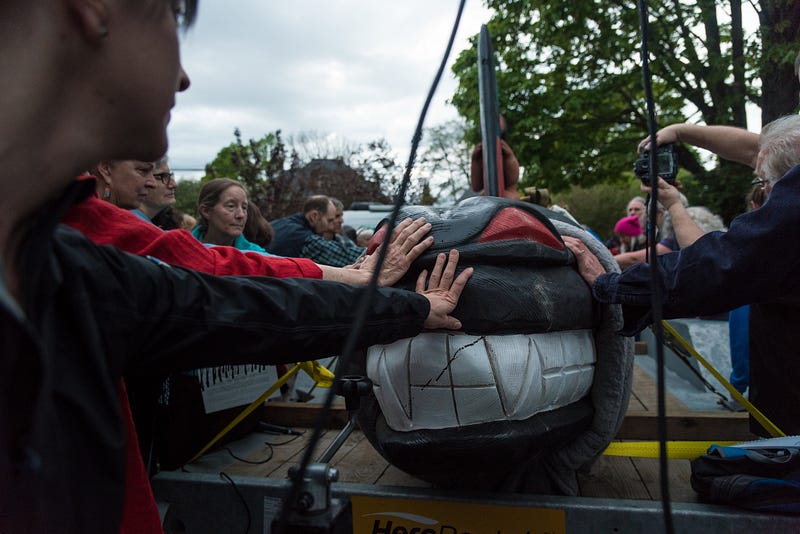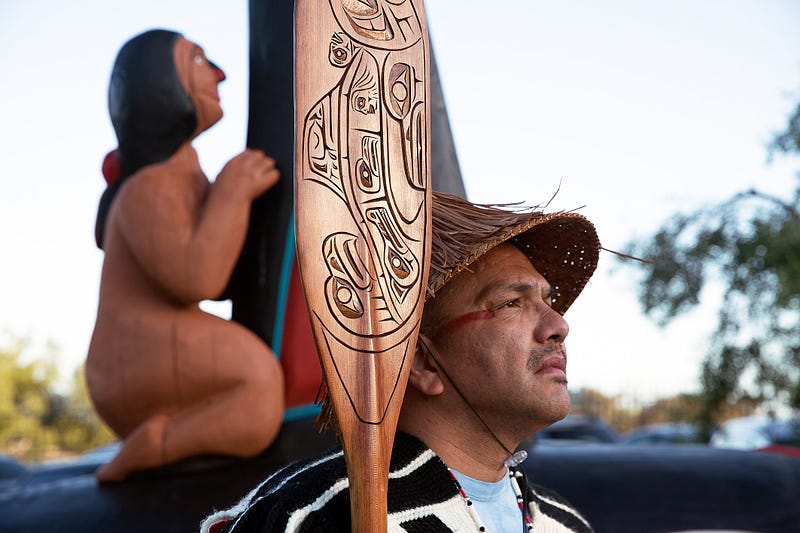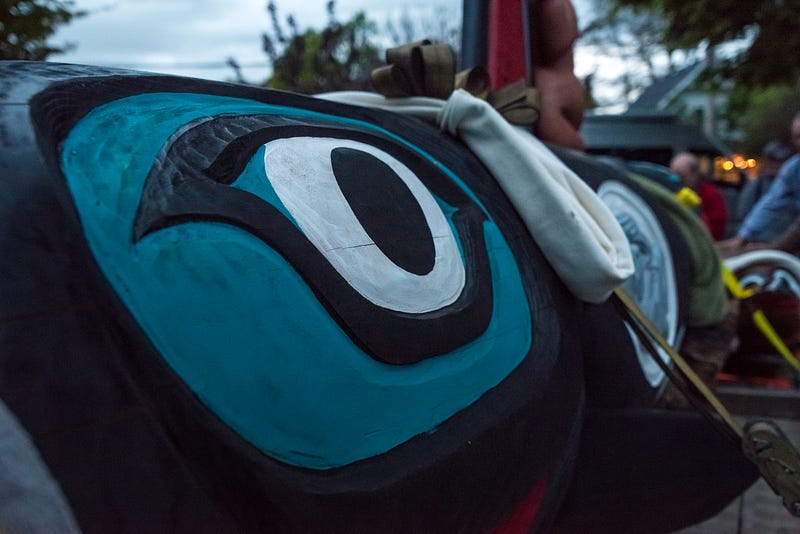The Fight for Orcas’ Lives
Story and video by SARAH PORTER
Photos by MATTHEW TANGEMAN and NANCY BLECK
How activists, scientists and legislators are trying to protect endangered southern resident killer whales
[embed]https://www.youtube.com/watch?v=wgC0hW5wOjs[/embed]
Hundreds of people stand with their hands on a 16-foot-long totem pole carved into an orca, blessing the art piece before it leaves Washington state to cross the U.S.
“We’ve got love like an ocean in our soul,” they chanted. “Heal our home.”
The totem pole, carved by Lummi Tribe member Jewell James, will make a 13-day journey from Bellingham to Miami as part of the the Lummi Tribe’s protest of a killer whale’s captivity at the Miami Seaquarium. They hope to convince the park’s new owners to release the whale back into the Salish Sea, where it was born.
The female orca, half a century old, floats in an oval tank alone at the seaquarium. She was named Lolita after she was captured from Washington state waters in 1970 and purchased by the Seaquarium. Before she was sold to perform, her name was Tokitae, a Coast Salish greeting which means “nice day, pretty colors.”
She was named by the Miami Seaquarium veterinarian who was sent to pick a companion for Hugo. The Seaquarium owners at the time renamed her Lolita, concerned that the name Tokitae revealed her ties to the Pacific Northwest and her wild origins.
Tokitae is a living memory of the killer whale captures that proliferated between 1962–73, in which 263 killer whales were caught out of British Columbia and Washington state waters. Netters made a total of $1 million from the sale of surviving whales.
The tank only has 35 feet of horizontal unobstructed swim-path, which is 13 feet short of regulation requirements for orcas and only 15 feet longer than the orca herself.

The Orca Network, founded by Howard Garrett and Susan Berta, has been major activists for her cause since 1995. The Lummi Tribe and the first peoples of the Salish Sea bioregion have joined together with Garrett, Ken Balcomb of the Center for Whale Research and People for the Ethical Treatment of Animals to urge Miami Seaquarium’s new owner to release Tokitae.
Garrett visited the whale in Miami on March 14 this year, where she swims in circles in a tank over 3,000 miles away from her original home. His description evokes images of a trapped, wild spirit.
“After the show, when trainers are gone off the scene, I’ve got videos of her just swimming,” Garrett said. “She’s just racing along at top speeds.”
Garrett believes Tokitae could live for another 20 years or so if she were brought home to the Salish Sea. She has fared well over the years in harsh, stressful conditions, presenting excellent energy and healthy teeth even now, he said. Lummi leaders agree.
“She must have a strong mind, a strong heart and a strong spirit to have endured,” James said.
Her tank in Miami is uncovered and exposed to hot, humid weather. National Oceanic and Atmospheric Administration (NOAA) orca researcher Brad Hanson said it’s extremely unnatural for a whale from the Pacific Northwest. The tank is filled with Atlantic waters, which makes it a subtropical environment, Hanson said.
Southern resident orcas’ natural environment is temperate, with temperatures as low as 28 degrees Fahrenheit in the winter and generally reaching the mid-70s in the summer. The lowest temperatures typically reached in southern Florida are in the mid-60s, with summer highs that can reach 100 degrees. Activists have claimed her black skin is burned by the sun, making it dry and wrinkled, causing it to crack and bleed.
Her relatives have been considered endangered species since 2005, but Tokitae wasn’t considered one of the endangered species until 2015. Her presumed mother, the second-oldest southern resident named Ocean Sun, still swims freely in the Salish Sea.
These conditions prompted the Lummi Nation to unanimously pass a resolution on Aug. 1 last year to bring her home.
“She deserves to be retired,” James said. “She deserves to sing her song into her mother’s ears.”
The Lummi Tribe and activists propose transporting Tokitae from the Miami Seaquarium to a sea pen off Orcas Island, near a Chinook salmon hatchery founded by Jim Youngren. The hatchery was founded to support the declining Chinook population, which is one of the southern residents’ preferred prey.
“That’s what his hatchery is about,” Garrett said. “He’s very happy to help Toki come home.”
Tokitae has linked together a small group of activists, researchers and legislators who have found a common cause. There are only 76 southern resident orcas left as of 2017, along with Tokitae in captivity.
—
Endangered southern residents face four major obstacles to recovery: prey availability, vessel disturbances, contaminants and their small population size.
These orcas are Hanson’s primary focus of study. He works closely with researcher Candice Emmons and two other team members to learn as much as possible about their obstacles.
Washington state Gov. Jay Inslee is interested in pursuing legislation to increase the population of Chinook salmon, which southern residents seem to rely on, so Hanson was directed to focus research on their diets. The research should be published by the end of this year, he said, which helps bulk up the literature pertaining to obstacle number one: prey availability.
Legislators are hoping to address the second obstacle to recovery, vessel disturbances, with the Orca Whale Protection Act. It would tighten restrictions on boats to reduce noise pollution.
To address the third obstacle, the NOAA researchers test contaminant levels of these orcas. In the ’90s, contaminants were a major concern, but the researchers have discovered that southern residents are less contaminated than transient orcas, who they share the Puget Sound with, Hanson said. He accounts this difference as being due to the two populations feeding at different trophic levels.
This is perplexing, Hanson said. Transient orcas have a stable population, but the southern residents struggle to thrive.
The final obstacle is the problem itself: the small population.
Most the of southern residents were taken in the 1970 Penn Cove captures, when Tokitae was taken from the Salish Sea. One of the estimated 45 young southern residents to be separated from the population, she is now the last survivor of the historic whale captures.
The whale hunters took a generation of southern resident killer whales, causing the population to drop from 96 in 1967, to a total of 66 in 1973.
Hanson’s research group discovered evidence of potential inbreeding in the population, which could prevent newborns from surviving to adulthood and compromise their gene pool. He also notes that factors like inbreeding can affect survivorship, but whether or not it happens at a young or old age is unclear.
—
Hanson sees similarities between killer whales and humans. Whales create strong social bonds with family members.
“I’ve been interested, since I was a kid, in killer whales,” Hanson said, describing his connection to the aquatic mammals.

When they are out in the field, Researcher Candice Emmons, who works with Hanson, can name the whales at a glance. Emmons got to know southern residents through decades of research and time spent on the water in her youth, she said. Her fascination began when she volunteered at the Center for Whale Research with Balcomb more than 20 years ago.
Each orca is an individual with a unique personality, Emmons said. Some are brave and have no fear of boats, while others shy away from unfamiliar things. Some are clingy mothers, who never let their babies out of their sight, and some let their babies become independent at six months, she said.
Garrett believes Tokitae still remembers her original habitat, and would likely recognize her mother. Their social and cultural connections are powerful, he said.
“Orcas and humans are parallel,” Garrett said. “It’s unlike any other animal.”
James believes the strength of orcas’ family bonds have kept Tokitae alive in captivity. She still sings the same song of her original pod, taught to her by her mother.
“We know that Tokitae has been singing her song alone,” James said.
—
Researchers at NOAA have a lot of concerns about whether releasing Tokitae into the wild would be the best solution, Hanson said.
She has been in a captive setting for the vast majority of her life — when Tokitae was originally captured in 1970, she was estimated to be between 3 and 6 years old. Removing her could be destabilizing, Hanson said.
Other considerations include the social bonds she likely has formed with her trainers, Hanson said. She has not had the option to bond with species of her own for 38 years.
Her previous tankmate, a male orca named Hugo, was a southern resident who was captured a year before her. He was known to hit his head against tank walls, so much so that the tip of his nose ripped off at one point, resulting in a scar, Garrett said. In 1980, Hugo rammed his head into the side of his tank until he died of an aneurysm.
Many believe the behavior was a reaction Hugo had after the Seaquarium moved Tokitae there. The whales were put in separate tanks to prevent fighting, but Hugo knew Tokitae was family, Garrett said.
“They called to each other constantly,” Garrett said. “Everybody in the park would hear their conversations all day long.”
Garrett knows Tokitae has a connection with some of her human companions, and hopes those close to her will travel to Washington for the reintroduction process, should it occur.
“Her trainer seems to have a real bond of affection with her,” Garrett said.
However, the human connections pale in comparison to the loneliness she experiences most of the day. She only spends a couple hours with her trainer, and the rest of her life is spent with dolphins that are rumored to be aggressive toward her, Garrett said.
Garrett, the Lummi Nation and Youngren believe reintroducing her to the wild population could allow her to live longer.
Hanson agrees Tokitae’s individual situation isn’t ideal for her, but it may be her best option.
Even if Tokitae could form bonds with the wild population, it may not be good for the species. Because Tokitae has been living in an unnatural, subtropical environment, and exposed to water from a different ocean, she may carry diseases that could be transferred to the wild population, Hanson said.
Garrett said this isn’t much of a concern. They would enlist veterinarians and researchers to examine her thoroughly, just like researchers did when attempting to free Keiko, the orca who starred in the 1993 movie, “Free Willy.”
—
Hanson worked closely with the six researchers recruited to free Keiko, who was captured in 1979 at 2 years old somewhere off the coast of Norway.
He was involved in the tagging and monitoring during Keiko’s trial release process. Hanson and the other researchers tried to release Keiko back into the ocean between 2000–2002.

Keiko was never able to integrate into the wild population. He was taken back under human care in a free access enclosure constructed for him back in the Norwegian sea, where he died in December 2003. Hanson weighed the various similarities and differences between the two cases.
“We didn’t know which population he came from,” Hanson said. “With Lolita, we do.”
Keiko was also in captivity for less than half the time Tokitae has been. And Keiko did not survive. He died around age 26.
Female northern resident Springer was the only successful killer whale reintroduction to the wild after human intervention. She was separated from her pod in 2002 when her mother died, Hanson said.
Garrett watched rescue team leader Jeff Foster, who was also involved in the campaign to free Keiko, capture Springer so she could be reunited with her mother. Garrett wrote a chapter about Springer’s rescue for the peer reviewed journal, Between the Species.
Springer was only separated from her pod for a short period of time, Hanson said, and was held in captivity for a short rehabilitation period. Without any similar success stories, it’s hard to determine the long term viability of reintroduction, or the potential effects on the wild population.
—
Activists, researchers, legislators and tribal leaders have converged to protect the southern residents, and push for Tokitae’s return. Tokitae’s fight garnered renewed energy after PETA and Garrett lost a lawsuit against the Miami Seaquarium.
The last legal avenue to bring her home has been exhausted, Garrett said.
On Jan. 12, 2018, an appeals court reached a decision in a lawsuit filed by PETA and Howard Garrett of the Orca Network against the Miami Seaquarium. They claimed Tokitae’s current environment is harmful and harassing to her, which is prohibited under the Endangered Species Act. PETA had successfully petitioned the National Marine Fisheries Service to include Tokitae in their list of endangered species in January 2013, which made her protected.
However, the court said the Endangered Species Act was intended to prevent species extinction, and that Tokitae’s current condition is irrelevant to the species’ survival. She is a post-reproductive female, Hanson said.
The court considered the harm of Tokitae’s imprisonment as minimal, and determined that only serious harm is actionable under the Endangered Species Act. The Miami Seaquarium could keep Tokitae or choose to release her, but the law would not compel it.
“Nothing has been ruled in our favor,” Garrett said. “There really isn’t any other legal remedy that I can see at this point.”
PETA can choose to appeal and take the case to Florida Supreme Court, but there haven’t been any decisions made yet, Garrett said. For now, the hope is that the new Miami Seaquarium owner will voluntarily release Tokitae.
“We have written letters to them, the Lummis have written letters to them and we get no response,” Garrett said.
The new owners are a subsidiary of the Spanish theme park company, Parques Reunidos. They took over in 2015 at the Miami Seaquarium. Garrett hopes they will eventually break through to them. With enough public support, he thinks they will listen.
